Content
- 1 Positive aspects of street culture
- 2 Variety or hybrid?
- 3 Selection of varieties for open ground
- 4 Review of the best varieties of tomatoes for 2017-2018
- 5 Tomato varieties for various characteristics
- 6 Reviews of gardeners: the best varieties for open ground for 2017
- 7 Eagle heart
- 8 Koenigsberg
- 9 Abakan pink
- 10 Chio-chio-san
- 11 Apple tree of Russia
- 12 Monomakh's hat
- 13 Puzata khata
- 14 Golden domes
- 15 Eagle beak
- 16 De Barao
- 17 Bull heart
- 18 How to choose the best varieties for sowing
- 19 The best varieties of tomatoes for 2018: universal for the greenhouse and open ground
- 20 The best varieties of tomatoes for greenhouses
- 21 Harvest varieties of tomatoes for open ground
- 22 Varieties
- 23 Early
- 24 Medium varieties
- 25 Late varieties
- 26 Large-fruited varieties
- 27 Sweet varieties
Tomato is a vegetable of tropical origin, but in most agricultural regions it is successfully grown not only in greenhouses. Various varieties of tomatoes for open ground have been bred, and the list is constantly updated. Many years of selective selection have adapted this valuable crop to a temperate climate. The best outdoor tomato varieties adapt well to different weather conditions. Consider varieties and hybrids popular for 2017-2018.
Positive aspects of street culture
The greenhouse is deservedly considered a more reliable option. However, growing tomatoes in soil has several advantages:
- vegetables are tastier and healthier;
- attacks of pests and diseases are less aggressive, less destructive;
- lower financial and labor costs;
- the yield of simple varieties is practically not inferior to those of hybrids.
Seed companies offer growers a choice of hybrid and non-hybrid varieties.
Variety or hybrid?
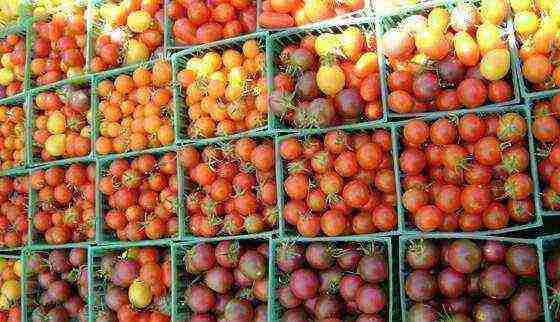
Indoors, the advantage of hybrids (in all respects, except for the taste and weight of the fruit) is more obvious. For open ground, breeders also offer resistant varieties of tomatoes of hybrid origin, they are resistant to diseases and temperature contrasts.
But numerous reviews indicate that amateur gardeners still prefer non-hybrid forms - they are considered more tasty and aromatic, and you can also get your own seeds from them (this is free, plus a guarantee of germination and varietal purity).
Selection of varieties for open ground
For greenhouses, indeterminate tomatoes with an extended growing season are certainly more profitable. For street beds, the criteria are much broader, but the selection itself is stricter. There is more dependence on a variety of conditions - the climatic zone, microclimate, goals and capabilities of the gardener.
More information about the best varieties of tomatoes for greenhouses for 2017-2018.
We can say that there are three types of street culture:
- reckless way;
- planting seedlings under a temporary shelter;
- planting seedlings immediately under the open sky.
For different climatic zones, the set of varieties for each method will be different, but there is a general rule: mid-late and late ripening periods are not suitable for open ground.
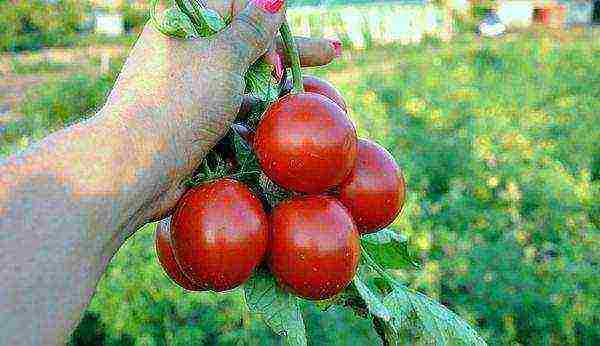
The restrictions on the height of the bushes depend only on the climate and technology: tall varieties of tomatoes will not reveal their potential with a short summer and lack of good support.
Agricultural technology options:
- In regions with warm summers, tall tomatoes can be planted in the ground - if it is possible to provide strong support (trellis), timely pinching, worthy of top dressing. Only in this way will the most productive varieties of tomatoes be able to reveal their potential.
- In recent years, semi-determinant tomatoes have become increasingly popular. This is sometimes called determinant varieties and hybrids of medium height (100-130 cm). As a rule, they are universal - they are suitable for both open and closed ground. Simple pegs are suitable for them, moderate pinching is required. The yield is decent.
- Low-growing tomatoes are less labor-intensive, they are unpretentious. It is advisable to pinch them to the first brush - for earlier ripening, but this procedure is not mandatory. Excessive pinching leads to a decrease in yield. A thickened fit is sometimes used.
- For very early varieties (low determinants and super determinants), a seedless cultivation method is possible. This does not mean direct sowing into the ground, but the arrangement of at least a minimal greenhouse with heat accumulation.
In 2018, the gardener has the opportunity to test the latest breeding achievements and compare them with old, proven tomato varieties.
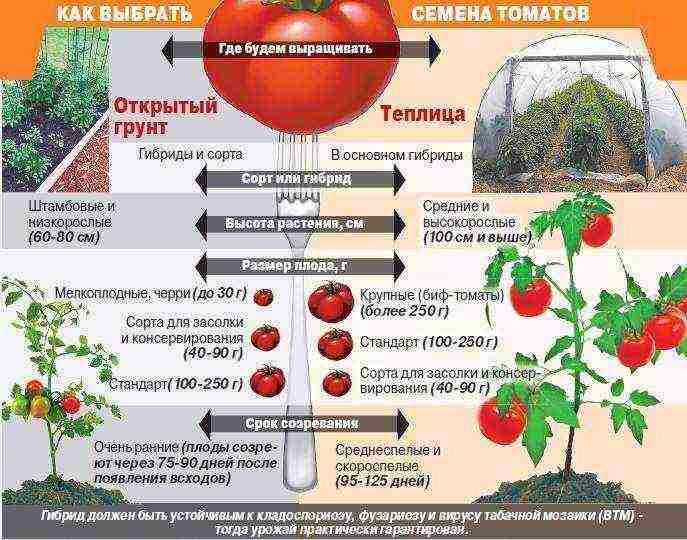 Scheme: How to choose tomato seeds for greenhouses and open ground
Scheme: How to choose tomato seeds for greenhouses and open ground
New varieties
- Argonaut F1
- F1 biggie
- Red bud
- Persianovsky F1
- Phantom F1
- Tsaryok F1
- Chelyabinsk meteorite F1
Review of the best varieties of tomatoes for 2017-2018

Below we will consider the popular varieties of tomatoes for open ground for their purpose and various characteristics.
The best varieties according to reviews of gardeners
An important criterion for a reliable variety is a stable yield from year to year, the ability to adapt to different regions and weather conditions. Such plants invariably delight the owners.
Fighter (Brawler)
This popular patented variety of Siberian selection is a champion in unpretentiousness. Seedlings do not stretch, they lay buds after the 6th or 7th leaf. The bushes do not get sick with the tobacco mosaic virus, they grow up to 45 cm. Garter and pinching are at a minimum (you can do without them).
Ripe cylindrical fruits are ready for harvesting 3 months after germination, weight in the lower hand - 180 g, then - 70-90 g. Harvest - up to 5 kg per square meter. The appointment is universal.
Big Mama
Early ripening (85 days) novelty from the Gavrish company. The bush is medium spreading, of moderate height. The tomatoes are heart-shaped, large enough (200-250 g) and fleshy for such an early period.
Pink stele
A mid-early variety from Siberian breeders, consistently producing 6-10 kg per square meter. The internodes are close together, the total height of the bush is about half a meter. Compact in seedlings.
The first fruits are elongated heart-shaped, up to 300 g, the subsequent ones are cylindrical, 120-200 g each. Coloring - pinkish-crimson, fleshy consistency, few seeds.
Tanya F1
Dutch hybrid with high productivity and disease resistance. Bushes are powerful, but compact, about 0.7 m high. Tomatoes are spherical, even, 150-200 g. They are dense, but not too hard. Lying, do not wrinkle in transportation. Maturing dates are medium early.
Sheriff F1
A novelty hybrid of the Transnistrian selection. Combines very early ripening (from 89 days) with a solid weight of round, strong fruits (up to 250 g). Long-term fruiting.The brushes begin to form above the 5th leaf, then go through the leaf.
The bush is semi-determinate, vigorous (up to one and a half meters), resistant to viruses and alternaria spotting. Productivity up to 20 kg per square meter.

Early (early ripening) varieties
Early varieties of tomatoes do not have time to gain fleshy pulp, but they are so long-awaited that they seem to be the sweetest. They are able to ripen on the vine even in the northern regions.
They are often characterized as resistant to late blight, but this is not entirely true: they just manage to give up most of the harvest before an infectious attack.
Betta
A tomato from the "Gavrish" company with a unique early maturity: it turns red after 78-85 days from the beginning of the growing season. Does not stretch in seedlings, blooms early; requires disembarkation to a permanent place at the age of 1 month. It gives off the harvest quickly, therefore it does not get sick; frees up the bed for re-planting.
Standard bush, compact, less than half a meter. Suitable for thickened placement. Tomatoes are spherical-flattened, 50-70 g in size; collection from a bush - 1.5-2 kg.
Katya F1
An ultra-early (75 days) proprietary hybrid from the Semko company with amicable response in any conditions. Determinant. Brushes begin to appear already above the 5th leaf, carry up to 8 ovaries. Fruit weight from 80 to 130 g.
High resistance to cracking and disease. Productivity more than 10 kg per square of area.
Half-fast F1
Hybrid tomato from Dutch breeders with the first harvest 86 days after germination. For such early dates, the fruits are surprisingly dense, good taste, weighing up to 150 g. The bushes rise 0.6 m, they are well resistant to diseases and cold snaps.
Ultra-ripe
The ripening period is from 80 days, the growth of the bush is 40 cm, the mass of the scarlet rounded fruit is up to 100 g. Passynching is not required. A seedless growing method is possible.
Jurand F1
New selection from Transnistria. Disease-resistant, very early (from 80 days) hybrid with extended and high total output - up to 16 kg per square meter. Determinate bushes, up to 0.8 m. Fruiting begins after the regrowth of 5 leaves.
Tomatoes are spherical, transportable, weighing 90 g.
Undersized
Small tomatoes (25-45 cm) require minimal maintenance. Standard varieties with a thick stem do not even need to be tied up.
Low-growing varieties of tomatoes for open ground do not need to be pinned.
Grigorashik F1
Dwarf superdeterminate hybrid for indoor, pot, ornamental culture. The sheet is beautiful, corrugated. Tomatoes weigh 30 g. The stem length is no more than a quarter of a meter. Can be used in soil and greenhouse as a sealant.
Gratifying
A standard bush 35 cm high successfully withstands cold snaps and temperature stresses. Begins to ripen 3 months after germination. Round tomatoes weigh about 60 g. Plants branch weakly, do not need shaping.
Superkluck
Brand new from "Siberian Garden". Fruiting dates are medium early. Tomatoes are hidden by dense foliage, they are pink, up to 250 g in size, ripen on the vine. The stem is of the standard type, not higher than 40 cm.
Turbojet
New Siberian tomato, very early. Cold-resistant and unpretentious. A 40-centimeter bush brings up to two kilograms of tomatoes weighing 60-80 g. You can not pinch or tie.
Shuttle
Early ripening (from 82 days) pickling variety with a standard bush not higher than 0.45 m. Fruits are oval-elongated, with a "nose", strong, beautiful, weighing 30-60 g.
Tall
Tall ground tomatoes are classified as semi-determinate or indeterminate. Semi-determinants, as a rule, stop growing themselves, tying the optimal number of hands. Indeterminants need to be stopped in time - to tip (pinch the growth points of the main stems) at the end of the season.
Regular pinching is a must.
Mirsini F1
Semi-determinant (1.3 meters) early Dutch breeding hybrid with excellent disease resistance and high recoil.Tomatoes are round-flat, very strong, large - up to 400 g.
Novosibirsk pink
A new early maturing variety with a stable ovary. Plants are medium-sized, compact. Cuboid-elongated tomatoes, weighing 100 g each, pickling type, attractive pink shade.
Normandy
Thanks to a tall bush (150 cm), this tomato successfully combines early harvesting of the first fruits (90 days) with long-term yield and high yield - up to 10 kg per square meter. The mass of one tomato is about 160 g; the pulp is tender, for salad purposes.
Seven
A mid-season variety, bearing up to 6 kg per bush, is resistant to diseases. Indeterminate plants require a secure garter. Globular tomatoes weighing 150 g have an excellent taste.
High Color 312 F1
A powerful semi-determinant up to one and a half meters high. The setting of the first ovary is very early - above the 5th leaf. The return is long-term, the overall yield is high. The fruits are extremely dense, salting type, have the shape of a plum, weight 70 g. Imported from Holland.
Disease resistant
High resistance to diseases is laid down at the genetic level. The guaranteed, obvious effect is shown in hybrids.
The rest of the varieties (especially mid-season ones) in terms of health are more dependent on agricultural technology and weather conditions.
Caspar F1
The newest hybrid of English selection. Early ripening (from 85 days), powerful, determinant. Each cluster contains up to a dozen fruits weighing 200 g - even, raspberry-pink.
Diabolic F1
Mid-season hybrid from Japan. Determinant, salting. Elongated pepper-shaped tomatoes, strong, weighing 150 g.
Cameo
Ultra-early (89 days), productive tomato of Russian selection. Withstands stress, cold snaps, diseases (even late blight). The bush grows no higher than half a meter, does not need pinching. Fruits are one hundred grams, even, smooth; keep pace with each other.
Magnus F1
Cold-hardy Dutch hybrid with abundant ovary. It successfully resists nematodes, viruses and fungal diseases (even phytophthora). Bushes grow to a medium height, tomatoes weigh 150 g.
Phytous
Medium early, compact, low (0.5 m) variety. Stealing is not necessary. It produces a harvest (about 11 kg per square meter) in the mid-early period. Oval-pear-shaped tomatoes, 50-70 g each, for universal use.
The sweetest
Sugar non-hybrid tomatoes are considered the most delicious. The sweetish taste of tomatoes is made up of several indicators: the amount of sun and moisture, nutrition, genetic predisposition to the predominance of sugars over acids.
There are truly sweet varieties.
Djalo Santa
Mid-season, medium-sized (0.7 m) variety, tolerant of cool weather and dry soil. Tomatoes are honey-yellow, fruity-sweet, weighing about 150 g. The yield per square meter is up to 8 kg.
Pink honey
A popular Siberian tomato in the shape of a heart, with a record weight of over a kilogram, fleshy and aromatic. The bush grows 0.7 m and needs good feeding and shaping.
Russian delicious
Branded mid-early tomato from the "Gavrish" company with dessert fruits up to 300 g. Resistant to diseases. A bush of moderate height (0.8 m), brings up to 4.5 kg. Stealing is a must.
Super sweet miracle
A medium-ripening variety from Uralsky Dachnik, weighs 150-200 g, sugary. Plant height - 0.7 m. You can not pinch. Disease resistance is high.
Southern tan
Pepper-shaped orange tomatoes are poured up to 350 g and taste like ripe apricots. Long-term keeping quality. The bushes are indeterminate, with a good ovary, even in open field conditions - no wonder this is a Siberian selection.
Ripening times are average, the yield per plant is up to 8 kg.
Cherry
Most cherry tomatoes are characterized by early or medium early ripening of the first fruits. Even tall cherry trees can be grown outdoors (provided the necessary supports are available). However, there are also special options with restrained growth.
Children's sweet "cream"
On a low bush (0.5 m), oval tomatoes weighing 30 g, deep red in color, quickly tied and ripen in unison. In a brush up to 10 pieces.
Pearl yellow
Standard determinant up to 30 cm high - patented "kid" from the "Sedek" company. Ultra-early (85 days), shade-tolerant. Honey-yellow cherries weigh 20 g each.
Sweet meeting
The Vkusnoteka series from the Poisk company. The bush is medium-sized, needs a garter. Tomatoes are deep pink, weighing up to 20 g, in beautiful tassels.
Sweet kiss
Plants reach a height of 80 cm. Tomatoes are red, sugary, up to 20 g. Siberian selection.
Unique F1
The original cherry hybrid from the Semko agricultural firm. Tomatoes are in the shape of a cylinder, weighing up to 30 g; the color is dark red. The bushes are low, standard, disease-resistant. Ripening period - ultra early (from 80 days). Recoil per square meter - more than 7 kg.
Tomato varieties for various characteristics

The most productive
- F1 debut
- Eagle beak
- Diva F1
- Tiberias F1
- Yaki F1
Not requiring pinning
- Gigolo
- Mystery
- Lazy
- Nepas
- Nizhny Novgorod kudyablik
Large-fruited
- Eternal Call
- Regiment Commander
- Crimson giant
- Buffalo heart
- Bakery
For salting
- Lady fingers
- Classic F1
- Mariana F1
- New product of Transnistria
- Rocket
- Semko-Sinbad F1
Black
- Vranac F1
- De barao black
- Chocolate bunny
- Black Moor
- Cherry Negro F1
Yellow
- Buyan yellow
- Golden heart
- King of Siberia
- Fruit jelly yellow
- Top Model
Pink
- Pink pear
- Liana pink
- Pani Yana
- Gift to F1 woman
- Pink Katya F1
- Pink cheeks
Dutch
- Bobcat F1
- Incas F1
- Perfect saw F1
- Polbig F1
- Sunrise F1
- Hypeel 108 F1
For Moscow region
- Beauty of Moscow
- Krasnaya Presnya
- Moskvich
- Neptune F1
- Peremoga 165
For the middle lane
- Explosion
- Gina
- Liang
- F1 bride
- Sanka
- Semko 2010 F1
For Siberia
- Demidov
- Spark of Siberia
- Kemerovets
- Nastya Sibiryachka
- Heavyweight of Siberia
- Sorcerer
For the Urals
- Benito F1
- Quiz
- Dunn
- Rocket
- Semko 98 F1
Reviews of gardeners: the best varieties for open ground for 2017
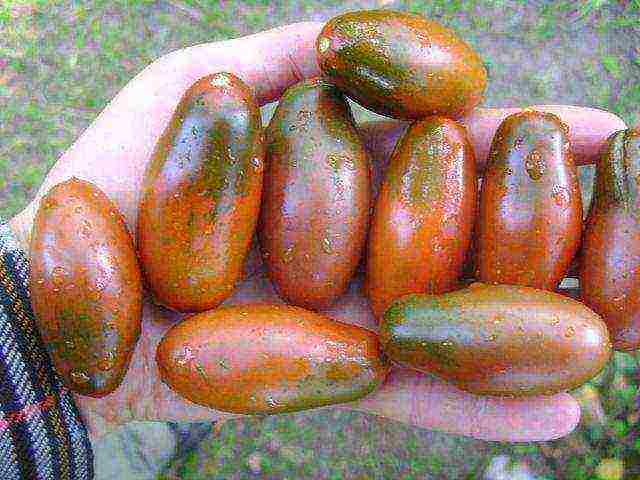
Given the climatic conditions of our country, it is difficult to grow such a heat-loving culture as a tomato in the open field. It is much easier to do this using a greenhouse. However, if it is employed under another crop or is simply absent, then under certain conditions, tomatoes can be grown in the open field.
According to the existing opinion, they will be even more useful than greenhouse ones.
The main thing is to choose the right kind of tomato so that it is desirable:
- early ripening - early (ultra, - ultra-early) varieties will make it possible to grow crops in a relatively short warm season, avoiding possible late spring or early autumn frosts;
- undersized, in extreme cases, medium-sized - in order to better withstand wind loads in an open space, even with relatively weak support.
Let's try to determine which early ripening and undersized tomatoes are most often well-spoken about on forums and social networks, which varieties are recognized as the sweetest and (or) tastiest.
The sweetest varieties
Many amateurs appreciate the presence of a sweet aftertaste in the taste range of tomatoes. Therefore, varieties that can be conditionally classified as sweet are very popular for cultivation. The following of them received a lot of good reviews from specialists and ordinary gardeners:
- Big Mom is an early, relatively new variety with a fruit weight of up to 300 grams. Typical comments “Excellent taste”, “The sugar pulp resembles a watermelon”, etc .;
- The yellow giant is a medium-sized early variety with delicate pulp and low acid content, its fruits reach a weight of up to 700 grams. “Loved the intense sweet taste” and “Excellent variety” are typical reviews .;
- Leo Tolstoy is a hybrid medium-sized variety with a fruit weight of up to 300 grams. "Very juicy and tasty fruit, the cut even sparkles in the sun" - one of the many positive statements about this variety available on the forum.
They also speak well of sweets and other varieties, such as, for example, Uvalen, Pink honey, Sweet kiss, Sweet tooth, Aphrodite, Valentine, etc.
The most "delicious" varieties of tomatoes
 Pink king
Pink king
It is difficult to give the concept of "taste" unequivocally. Pickles and dark chocolate can be tasty, while sweetened soda can be sugary and disgusting. What combination of components makes a product tasty (in our case tomato) or not tasty is often impossible to determine.
However, such a seemingly subjective opinion about the deliciousness of the product did not prevent consumers from dividing tomato varieties according to this criterion and highlighting the best ones.
More often than others, in 2017-2018, the following varieties of early ripening tomatoes were praised by gardeners:
- The Pink King;
- Siberian troika;
- Explosion.
“Excellent taste”, “I planted it on recommendation, I liked the taste very much, I will now plant this variety all the time”, “Juicy and very tasty fruits, I advise everyone to grow it” - such or similar statements were accompanied by reviews of these varieties.
Of course, this list is not limited to "delicious" varieties of early ripening and low tomatoes. Moreover, some will believe that the mentions of dozens of other varieties in this list are undeservedly forgotten. And this is good, it means that there is a wide selection of excellent "tasty" varieties of tomatoes for growing outdoors, even in our not the most favorable climate.
Real battles unfolded during the voting for the most productive varieties of tomatoes that our readers have grown in their beds. Evaluated according to different criteria - from frost resistance and keeping quality, to taste and pickling qualities.
Amateur tomato growers voted for many varieties, which pleased them with their unpretentiousness and productivity in specific conditions. It is simply impossible to mention all varieties of tomatoes in one article. Therefore, we will list only those who, according to practitioners, have become the absolute leaders of the rating. And who, if not tomato growers, can be trusted 100%.
Let's start at the very bottom of the rating and tell you about the tomato varieties that received the least number of votes. However, this does not mean that these tomatoes are bad or weak and should not be grown. It's just that it's not customary to argue about tastes.
Eagle heart
A tomato with the proud name Eagle Heart occupies the bottom line of our top. Everyone who grows these giant tomatoes with an elongated tip, shaped like a heart, leaves only positive reviews about it. Fruit weight reaches 600-800 g, and sometimes up to 1 kg. One such pink-raspberry fleshy "hulk" - and you can feed the whole family with salad! The pulp of a tomato is sugary, juicy and sweet.
The variety is determinant, with an average ripening period - in a greenhouse with nutritious soil, the bushes grow up to 170 cm and need to be pinned and tied. Outdoors, they may be slightly lower. But their yield sometimes exceeds 10 kg per bush. For the sake of such impressive results, no effort is spared. Moreover, the tomato shows resistance to most diseases, does not lose its shape during transportation and can be stored for up to 3 months.
Koenigsberg
A mid-season variety of indeterminate (up to 2 m high) tomatoes, which confidently took the 10th line of our amateur rating. The first fruits usually ripen 110-115 days after sowing the seeds. Even beginners will be able to cope with their cultivation. The variety has been tested and hardened in the harsh conditions of Siberia. Therefore, you can safely plant these tomatoes in open ground. Their yield indicators are impressive - from 4 to 18 kg per 1 sq. M.
"Königsberg performed well both in the greenhouse and in the OG." Yuri Kuzminykh.
Oblong fruits ripen in clusters of 6 pieces, they weigh an average of 300 g, under favorable conditions the weight can be 2-3 times higher than the standard declared by the manufacturer. Both the skin and the flesh of tomatoes are dense, which makes them easier to transport.They are, of course, healthier fresh, but in the form of juice, thick paste or sauce, they are also very tasty. There are varieties of red and yellow color (Golden Koenigsberg).
“Königsberg is an excellent variety, bearing fruit throughout October, from one bush to 2 buckets. In the greenhouse, of course. " Lyudmila Petlyuk.
Abakan pink
On line 9 - a variety of medium late ripening (110-120 days from germination), determinant type (height - 70-80 cm). In a greenhouse, it can grow up to 140-150 cm. The bush must be formed into 1-2 stems and tied up. Fruits of pink color, heart-shaped (weighing up to 300 g) with tasty dense pulp will ripen on it. If cared for correctly, tomatoes weighing up to 800 g can be removed, which rival the popular Bull Heart in size.
There are many positive reviews about the cultivation of this tomato, no one criticizes it. It can be grown in Siberia, and for protection from recurrent spring or late autumn frosts, a light film cover will be enough for the bushes. This representative of the nightshade is rarely sick, it will be necessary to drive away the Colorado beetles only from immature seedlings. In a word, he will not create much trouble for you, but he will delight you with tomatoes - both in a salad in summer and in preparations for the winter.
“I recommend Abakan pink. Unpretentious and very tasty. " Lydia Domnikova-Kazakova.
Chio-chio-san
Of the shortcomings of this indeterminate (sometimes it grows up to 2 m) tomato - only the need for a bush in support and formation. The rest is a set of advantages! It is resistant to adverse conditions and can grow even in Siberia and the Far East. It bears fruit well not only in the greenhouse, but also in the open field. It is not afraid of the main diseases of the nightshade.
“In the greenhouse, I am always pleased with the Chio-Chio-san variety from Gavrish. Maria Dolzhikova.
According to the ripening period, the tomato belongs to the medium early - from the appearance of the first shoots to the beginning of fruiting, 100-120 days pass. It will not let you down with the harvest either - although the tomatoes are small (on average about 30-40 g), but they ripen up to 50 pieces. on the brush! So the harvest from a bush with proper care is 4 kg and can reach a record 6 kg. And the taste of this tomato is excellent! And in the blanks, it looks very presentable.
“Chio-chio-san - sweet, very productive, tall, with up to 50 smooth, thin-skinned sweet tomatoes in a bunch! Universal for food and preservation. " Tatiana Vznuzdaeva. Tula region
Apple tree of Russia
Tomatoes with such a quivering name could not help but get into the top - they ripen early - from the time the first shoots appear until the bushes are completely covered with small round fruits (weighing about 100 g) that really look like bulk apples, it takes from 118 to 135 days.
Many people consider this tomato problem-free - it is determinant, standard bushes grow low - up to 100 cm; you do not need to give them a shape and pinch them; they are not capricious and feel great and set fruits both in the greenhouse and in the open field. On one bush, up to 100 neat tomatoes suitable for canning can ripen at the same time - the skin will not burst, there is no need to be afraid. Not a tomato, but just a feast for the eyes!
Monomakh's hat
6th step of the conditional "pedestal". These bright red tomatoes will appeal to lovers of large fruits - they weigh from 400 to 900 g. The pulp has a balanced taste due to the harmonious ratio of acids and sugar.
The type of fruiting is medium early (90-110 days pass from the moment the seedlings are planted). Bushes are indeterminate, formed on a trunk. The plant successfully resists diseases, but prefers warmth to the cold, so in the northern regions it is better to plant it in a greenhouse. In conditions of protected ground, the yield is impressive and reaches 20 kg per 1 sq. M. In the garden, the indicators are also decent - up to 8 kg per bush.
Puzata khata
In terms of the number of votes won, he did not go far from the Cap of Monomakh. The appearance of these tomatoes fully explains the name.Large (300 g), pear-shaped, ribbed, just like squat houses for gnomes, these tomatoes ripen early - 105-110 days after transplanting. True, they turn red gradually if there is a lot of heat and sun. They are grown in the open field and under a film, where they ripen faster. Fleshy fruits, very sweet and juicy to taste.
The bushes are indeterminate, but even in a greenhouse their height rarely exceeds 170 cm.However, it will not be possible to do without formation. The stems are thin and need a garter, as they can lie under the weight of the fruit. And the yield of these tomatoes, ripening in brushes of 3-5 pcs., Show quite decent - 10-11 kg per bush. They are not very susceptible to common cultural diseases, but preventive measures of protection have not prevented anyone yet.
“This year, too, I want a Puzata hut. Last year they were with a friend - just a miracle! " Marina Samoilova.
Golden domes
The votes gained allowed these tomatoes to occupy the 4th line of the rating. In their "piggy bank" there are many good reviews, since the variety has almost no flaws, for which it is recognized and loved by many. It is highly resistant to major diseases, and timely applied insecticides will ward off harmful insects.
Determinate bushes (height from 90 to 150 cm), medium ripening period (100-116 days). You will still have to form it into 2-3 stems and tie it up, so it will not work at all without effort on your part. The yield is very good - up to 13 kg per bush with an average tomato weight of 200-400 g, and if the care is good, they will gain all 800 g! Ripe fruits are bright orange, juicy even in appearance. The pulp is fleshy, very tasty, sweet.
“I love golden domes very much - they are tasty, fruitful and beautiful. Excellent variety! " Love Chernoguz.
Eagle beak
The bronze "medal" and the 3rd place in the rating is received by the Eagle's beak, which is popular with many tomato growers! The variety is mid-season (110-115 days), semi-determinant - the height of strong bushes reaches 120-150 cm. Competent formation, tying to a trellis and timely pinching will help them develop harmoniously and bear fruit well. Under ideal conditions and with proper agricultural technology, the yield can be up to 8 kg per bush.
"Eagle's beak is the best, I have no competition yet, the leader for today." Olga Nesmeyanova.
The fruits are large, of an unusual shape, with an elongated and curved tip, similar to a beak. On average, they weigh 200-400 g, but some grow up to 800 g. The pulp is dense and juicy, with a sweetish taste.
The variety is resistant to the main diseases of the nightshade - late blight, fusarium and tobacco mosaic virus. Tomatoes tolerate transportation well due to their dense skin; they do not crack when canned.
"I really like the Eagle's Beak !!!" Nina Belevtseva.
De Barao
Breaking away from the rivals, the honorable 2nd place in the top varieties is occupied by the famous De Barao tomato variety. The variety is late ripening (ripening periods vary from 110 to 130 days from the moment of planting seedlings), indeterminate (2-3 m), sometimes bushes can grow up to 4 m. The main advantages of the variety are its cold resistance, shade tolerance and yield. These tomatoes grow well and ripen successfully in all regions with a temperate climate, both in greenhouses and in the open field. The plants are so unpretentious that even inexperienced gardeners can take care of them.
"Tall De Barao gives stable yields in any weather: rain or heat, even in the shade." Tatiana Trach.
The yield of De Barao is exceptional - from one bush you can collect from 4 to 10 kg of strong, oblong fruits weighing about 100 g. It is noteworthy that the plants give the crop for a long time (up to 3 months). There are varieties with pink, red, yellow and black fruits. Tomatoes keep well due to their dense skins and are suitable for pickling or pickling for the same reason.
“The only one who stood in the greenhouse and matured in October is De Barao. Persistent tin ... ". Tatiana Gorodetskaya.
Bull heart
The universally recognized and most popular variety of Bull's Heart becomes the absolute leader of the national tomato rating, with a record number of votes! A real Senior Tomato in all respects!
The variety is late-ripening - the first fruits (5 pieces in a brush) ripen 120-130 days after germination. In the open field, the yield is from 3 to 5 kg of tomatoes per bush. In a greenhouse, this figure can increase to 12 kg. Determinant type bush - stems grow up to 1.5 m or more. To achieve record yields, do not neglect leaving - timely formation and garter to the support, preventive treatment for late blight - and the harvest will not keep you waiting!
Tomatoes are heart-shaped, bright red in shape. Hybrids range in color from lemon and raspberry to deep brown and black. Average weight - from 300-500 g to 800 g and even up to 1 kg. On the bush, large specimens are located closer to the ground, smaller ones - in the upper part of the stem. The giant size of the fruit, dense pulp and unique sweet taste make this tomato an unconditional favorite of all gardeners without exception. This is confirmed by the voting on the portal and our rating based on its results.
“I planted a Bull's Heart, even in a cool and rainy summer season - it gave a good harvest. The husband adores him! " Tatiana Arzhanova.
If you still do not grow tomatoes because of fears that the weather will let you down, you will not be able to cope or the plants will die due to diseases or improper care, we hope that positive feedback and recommendations from the members of our Tomato Growers Club will convince you otherwise. And over time, on the pages of our website and in the group in social networks, you will also begin to enthusiastically discuss your new achievements and share your successes!
See the entire rating and comments of the participants
Good day to all readers!
Tomatoes are a favorite vegetable for many gardeners. They are grown both outdoors and in greenhouses and hotbeds. Breeders offer a large number of different varieties of tomatoes. Each one differs in color, shape, fruit taste, yield and agronomic characteristics.
From a huge variety of varieties, knowledgeable gardeners know how to choose the best ones that have proven themselves. Based on the characteristics and reviews, even a novice gardener can pick up exactly those varieties of tomatoes that will take root in any area and give a bountiful, high-quality harvest.
How to choose the best varieties for sowing
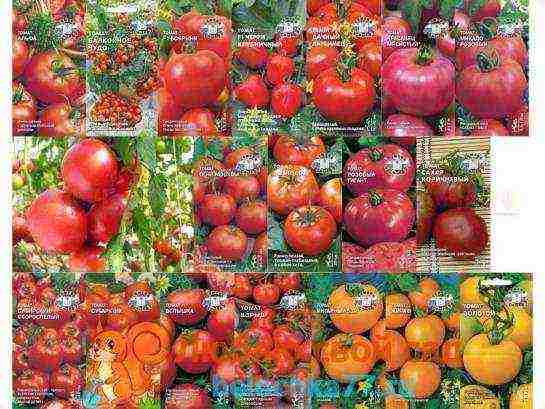
Tomatoes are quite demanding vegetables to care for. They need to be pinned, tied up, shaped. Without this, varieties that require the formation of a bush begin to hurt and give a meager harvest.
If there is no time for these procedures, you need to choose low varieties that are compact in size.
When choosing varieties for sowing, you need to pay attention to the characteristics of tomatoes.
The seed package must indicate whether the variety is intended for outdoor or greenhouse cultivation.
There are universal varieties. In the absence of such a mark, you can focus on the type of growth:
- superdeterminate are intended for planting in open ground and early harvest in the greenhouse;
- indeterminate suitable for greenhouses and open ground in southern regions;
- determinant varieties are grown in the open field and in the greenhouse.
To get an early harvest, you need to choose early ripening varieties. Tomatoes with a longer growing season ripen later, but can be harvested until late autumn.
You also need to pick up zoned varieties that are suitable for a particular climate. In Central Russia, tomatoes are most often grown in greenhouses, and in the south in open ground.
When choosing from varieties, it is better to buy tomatoes with increased resistance to diseases, cold, drought and winds.
Also, varieties must be chosen for their intended purpose:
- salad (dessert)
- for canning
- storage
- universal.
If you want to grow unusual tomatoes, you can plant varieties of different colors and shapes.
If you choose varieties based on their characteristics, you can get an excellent harvest.
The best varieties of tomatoes for 2018: universal for the greenhouse and open ground
The best varieties for 2018 are divided into universal, greenhouse and open field varieties.
Turbojet

The turbojet is a high-yielding, ultra-early ripening, unpretentious variety intended for growing in open ground and greenhouses. From the moment of germination to the formation of the first fruits, it takes 70-75 days. The variety is resistant to fungal and viral diseases.
The bush is low, no more than 40 centimeters. No garter required. The stems are strong and thick. The leaves are large, dark green. Fruits are flat-round, bright red in color.
Fruits are medium in size, weighing up to 200 grams. The skin is smooth. The pulp is fleshy, dense. There are many seeds.
The fruits do not differ in keeping quality. The taste is excellent. Tomatoes are suitable for salads, various vegetable dishes and canning.
Reviews:
elsa30
Variety Turbojet shook!
On the little bushes, 40-50cm each, a lot of fruits !!!!
But! In order.
Bushes are not pinned. As a result, bushes of 8-12 shoots are scattered on the ground, all covered with tomatoes. All my attempts to tie or prop them up were useless. Fruits from the very bottom to the tops.
I collected 1.5 buckets from 4 bushes, mostly of blanche ripeness, tk. in such weather, fita breathes in the back of the head, and the first to suffer are these little heroes lying in the garden in the OG.
Next year he will go to the feet of the Indets in the greenhouse. There is drier, straw and high beds.
Brown sugar
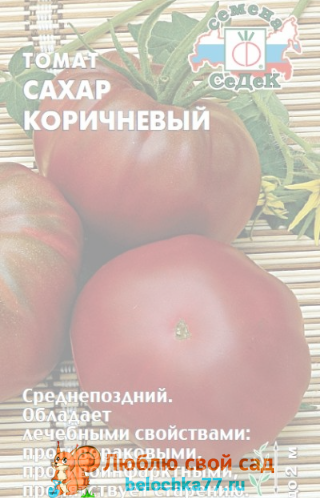
Brown sugar is a late-ripening, frost-resistant variety, suitable for protected and open ground. The harvest ripens in the fall. In favorable conditions, it reaches 2.5 meters. The bush needs a garter.
The brush consists of 3-5 fruits. The size is average. The shape is round. Weight reaches 150 grams. From 1 square meter (from 3 bushes), you can get about 8-10 kilograms of tomatoes.
The fruits are chocolate-pink in color. The taste is harmonious, combining acidity and sugariness. Tomatoes do not crack, they tolerate transportation well. Suitable for canning.
Reviews:
Lina Sakharnova
Brown sugar is more likely for pickling and canning, BUT the main feature is IT IS COLD. And in the fall, with the first frosts, the leaves hung, and the tomatoes were intact and ripened perfectly.
Batianya

The Batianya variety is high-yielding, early maturing. It is suitable for growing in open beds and greenhouses. It was created for regions with unstable climatic conditions. The variety is resistant to many diseases, temperature extremes and prolonged drought.
Indeterminate bush grows up to 2 meters. It is branched, requires pinching, garter. Leaves are dark green in color, large. 2 seedlings are planted per 1 square meter. The first fruits ripen 90-95 days after seed germination.
The fruits grow in clusters, are heart-shaped and crimson in color. The average fruit weight reaches 300 grams. The taste is excellent. The fruit is divided into 4 seed chambers. There are few seeds. Tomatoes are suitable for making salads, sauces, juices, tomato pastes. They can be stored well and can be easily transported.
Reviews:
OlgaP
Batyanya is still the only variety that I plant every year. Very productive, tasty, large, early, compact bush and what else I like is the fact that there is almost no dumping of flowers in the heat. I collect seeds every year just in case.
Babushkino

The variety is high-yielding, medium early, indeterminate. It is suitable for cultivation throughout Russia. From sowing to harvesting tomatoes 110-120 days pass. The variety is distinguished by its unpretentiousness and is grown both in the open field and in the greenhouse. It is resistant to low temperatures and various diseases.
The bushes are not standard, they reach 2.2 meters in height. Up to 12 fruits are formed on one hand.
The fruits are smooth and large. The weight is 300-800 grams. The shape is flat-rounded or ribbed in the area of the stalk.With high soil moisture, tomatoes may crack. The peel is pink-red in color. The pulp is firm, fleshy, bright red. There are few chambers and seeds in the fruits. The taste is classic.
Tomatoes are suitable for long-term storage. They are used to prepare salads, juices, sauces, tomato puree and winter preparations.
Reviews:
Valentine
I liked Babushkino's variety very much. Dacha near St. Petersburg. The climate is damp, and the summer is not hot this year, and the very first and a lot of tomatoes were tied. On July 2, the first red tomato was removed. Fleshy, sugar-yummy. There were no seeds in it at all, only tomato meat. In our region, even on the market, you cannot buy such. But what about the seeds ?????
Valery Medvedev
There will be seeds, but not in the first tomato, there are very few of them in this variety, but enough to take next year. Therefore, take from other fruits that will ripen later and grow next year.
Grandee

The variety is high-yielding, medium early. The growing season until full maturation is 105-120 days. It is suitable for growing in greenhouses and open beds.
The plant is unpretentious, frost-resistant, has good disease resistance.
In the Urals and Western Siberia, 300-500 centners can be harvested from 1 hectare. In the Omsk region, the yield reaches 600-700 centners.
The bush is determinate, low, from 55-60 centimeters to 1.5 meters high. It does not form a stem. 3-4 plants are planted per 1 square meter.
The plant requires pinching, a garter and strong support. To increase the size of the fruit, leave 4-5 flowers on the branches.
Tomatoes are large, fleshy. The skin can be from red-raspberry to dark pink. Weight 300-400 grams.
The shape is slightly elongated, cordate. Tomatoes have 6-9 chambers. The taste is bright, sugary.
The variety is ideal for salads, juices, tomato paste and preservation in general.
Reviews:
Little lily
I read that Budennovka is a rather old variety, and the Noble is recently bred. That the grandee improved Budennovka. I think to do this: plant one and the other in one hole, lead into one stem. Nutrition and care are the same and you will see xy from xy!
Banana feet
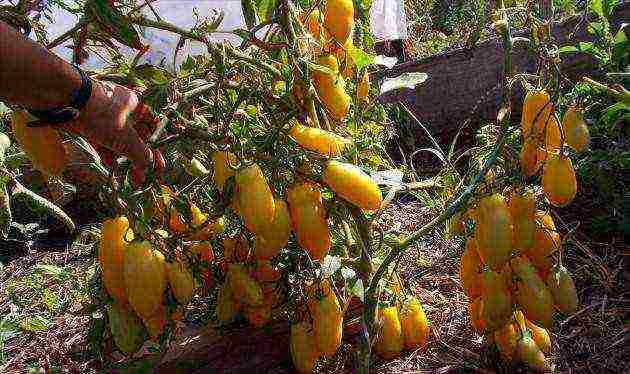
The variety is mid-season, high-yielding. Disease resistance is high. The variety is suitable for non-seedling cultivation in both indoor and outdoor fields.
The bush is determinate. On open ground, it grows up to 60-80 centimeters, and in greenhouses it can reach 1.5 meters. Leaves of a standard shape, green, very thin. A bush for a good harvest needs to be formed in 3-5 stems. The plant does not need pinching. From one bush, you can collect 4.0-5.5 kilograms of tomatoes.
Fruits are formed in clusters of 8-10 pieces. They are uniform. The shape is elongated, reaching 10-12 centimeters in length. Tomatoes look like an elongated plum. Weight ranges from 60 to 110 grams.
The skin is yellow-orange, dense. The taste is unusual, the smack is citrus. On unripe fruits, light green stripes are visible, which disappear when fully ripe.
Tomatoes are suitable for making sauces, salads, pastas, whole-fruit preservation.
Reviews:
Stall
Banana Legs
The plant is thin with thin branches and thin lacy leaves (two trunks in one hole got along perfectly). The fruits are icicle-shaped, 4-8 cm long, bright lemon color with green strokes, the strokes, as the fruit ripens, turn pale and disappear, there are few seeds. Since the fruits have low acidity, they were not particularly impressed when fresh, but the canned ones are very good: dense, fleshy, tasty, the skin is thick. Today I opened a jar of tomatoes in my own juice, Banana legs are delicious
Lyubasha

Lyubasha is an ultra early hybrid. From sowing to ripening, 70-80 days pass. Grown in greenhouses and open field. 3-4 bushes are planted per square meter. In the open field, you can get up to 10 kilograms of fruit from them. In greenhouses, the yield reaches 15 kilograms. The variety is unpretentious.Resistance to bacterial and fungal diseases is high.
The tomato does not tolerate low temperatures.
Shtambovji bush, determinate, height up to 1 meter. Per square meter planted no more than 4 bushes. The leaves are dark green in color. The stems are strong, do not require pinching and garters. A bush is formed on average 4-5 brushes. Fruit ripening simultaneously.
Fruits are medium in size, weighing 120-150 grams. The shape is round. The skin is soft, glossy, deep red. The flesh is juicy, firm, pale red. Seed chambers are large.
It is suitable for canning, pickling, eating fresh, salads. Transporting tomatoes well tolerated.
Reviews:
Maxim and Olga
Bought in the store the seeds of a hybrid Ljubasha to be grown in greenhouses. We were very pleased, as the seedlings quickly got stronger and after 2 months the first ripe fruits appeared. It landed just 2 rows of tomatoes Lyubasha, who richly fruited and provided our family with tasty and juicy fruits.
Diva
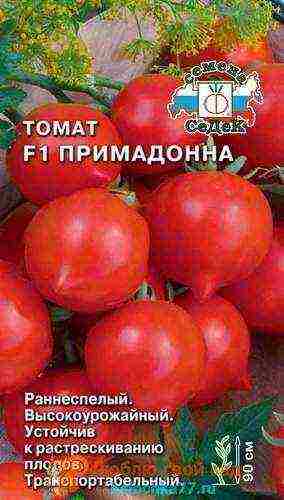
Hybrid versatile growing in the greenhouse, under the film and in the open field. It is grown in the harsh regions of the server. 90 days after sowing the seeds are collected the first fruits.
Yields as high as 20 kilograms.
The bush is determinate. Height reaches 120-130 centimeters. 7-8 brushes are formed on the bush.
The shape of the fruit is round, with a slight bulge at the bottom. The skin is red. Weight - 150-200 grams. The taste is pleasant, with a bit of tartness. Flesh is firm. The aroma is pronounced.
Fruits are easily transferred to transportation.
Reviews:
Meri
I have a "prima donna" of Aelita. The successful opening of last season, has grown in the greenhouse, the height of about 1 cm m.30, stepchildren were very few. Early well it sprang up in the heat. The fruit is medium, beautiful with a small spout, and tasted quite good for early tomatoes.
salt-coating miracle
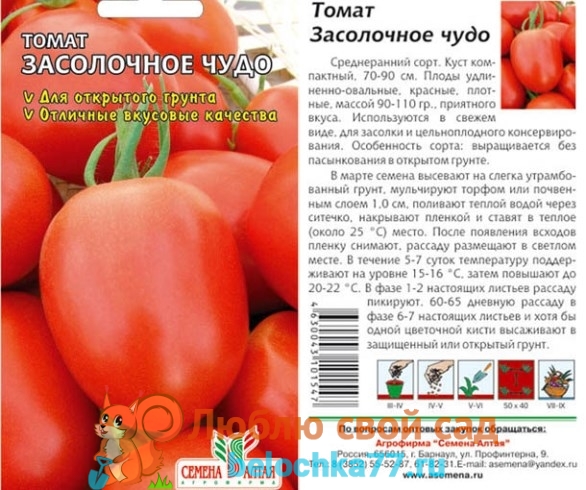
The variety is mid-salt-coating miracle. From germination to harvesting, 80-100 days pass. It is grown in protected and open field.
Standard bush, undersized. The height not exceeding 0.5 meters. Pasynkovanie carried out if necessary.
Fruits are not large, weighing 90 grams. On one bush is formed a large number of fruits. Form round tomatoes. The skin is colored bright red. Taste fresh and preservation without excessive sweetness, pleasant. The flesh is dense, durable, not fat. It preserves the integrity of the storage, transportation, and in a twist.
Cultivar was bred for stocking for future use. They are good and used fresh and for pickling and for pickling.
Reviews:
Oksana
Salt-coating miracle planting in the greenhouse (3-4), and the exhaust gas. High, tops Chica, if prevented. , -Byvaet and below, always with the harvest until October (in the greenhouse)! Beautiful, delicious, always a lot!
The best varieties of tomatoes for greenhouses
Honey

The variety is determinate, mid. From transplanting to harvest passes 105-110 days.
Grade undemanding in care. Resistance to diseases and temperature extremes it is good. In greenhouse conditions, this variety can be grown in any region of Russia. Outdoors it is mainly cultivated in the southern and middle-climatic zones.
Shtambovji bush of medium height, 1.1-1.4 meters in height. On the one bush can collect 3.5-4 kilogram of fruit. With a planting scheme of 3-4 bushes per square meter, it turns out 14-16 kilograms of tomatoes.
Fruits are pink or bright pink color. Flattened form. Size large, up to 350-500 grams. The number of cameras is not more than 5-6 pieces. Taste perfectly combines acidity and sugar content. Fruits are good in fresh and salt form. They are used to make juice. In tselnoplodnom canning are not used, as they have a large size.
The fruits are well kept and easy to carry long-distance transportation.
Reviews:
Ulyana
Tomatoes "support" for a long time. I tried many varieties. I most large-fruited and delicious for everyone. "Rubber" hybrids are not planting. Tomato should be such which raised even by our grandmothers.One of the favorites is the Honey tomato. With good care, it grows by 0.5 kg or more. The taste is simply amazing, it lives up to its name. I will never part with this variety.
King of Kings
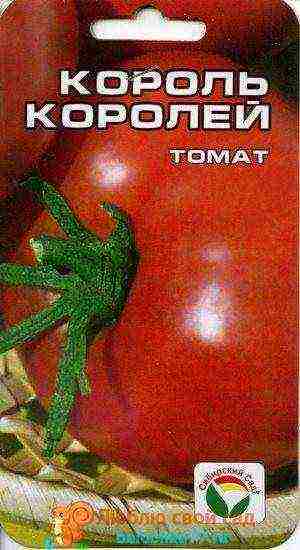
King of Kings, this is a complex high yielding F1 hybrid of late to mid-late ripening. From planting seeds to harvesting, 110-120 days pass.
Greenhouse cultivation is suitable for the Middle Lane. In the South, the variety is cultivated without shelter.
Late blight resistance is high.
The bush is indeterminate, not standard, 1.5-2 meters in height, strongly branching. Average leafiness. The plant requires shaping. He is tied to a long support.
With good care, you can get 5 kilograms of tomatoes from one bush. Fruits grow in 5 pieces on one brush.
The fruits are large and beautiful. Weight ranges from 200 to 1500 grams. The skin is bright red, slightly ribbed, smooth. The shape is slightly flattened, rounded. The pulp is not too juicy, firm and fleshy. Each fruit has 4 to 8 seed chambers, thick fleshy septa.
The taste is sweet, pleasant, with a slight sourness. Tomatoes are not used for preservation and pickling, this is a hybrid of table purpose. It is used for making salads, pastes, juices, purees.
High transportability. Keeping quality is good.
Reviews:
Tatiana, Yekaterinburg
I liked the variety with its tomato flavor and large fruit size. The bush is high, not spreading. You need to tie up the bush right away, since the fruits are all large. Good variety, but late. I will plant more.
Eupator
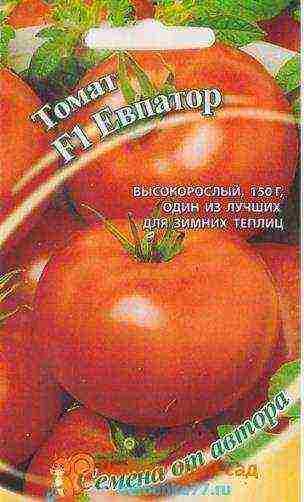
This is an early, high-yielding hybrid. It is mainly grown in greenhouse conditions. When planted outdoors, the yield is slightly reduced. Seeds for seedlings are sown 45 days before planting in the greenhouse.
The first fruiting begins 110 days after seed germination. From 1 bush in the open field, you can remove 6 kilograms of fruit.
From a square meter (3 plants) in greenhouse conditions, you can get 40 kilograms of tomatoes.
The variety is resistant to many diseases.
Tall shrub, cultivated in one stem. The plant requires a garter. The stepsons need to be removed.
Fruit weight is average, about 130 grams. The skin is red. The fruits are very tasty, do not crack, even when preserved. The taste has a slight sourness.
Reviews:
Astra
I have Eupator growing up for the fourth season. I am very happy with it. Very productive for our climate. But 50 kg is not for us. Their growth is just limited, it is necessary to transfer to the third stepson, but I am not a stepson, (the stepson is only downstairs) therefore they themselves are transferred and grow without restriction.
A pineapple
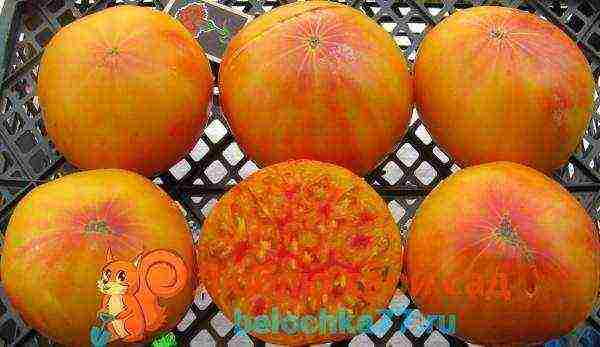
A variety of medium ripening. From the time of seed germination, 120-130 days pass. It was bred for indoor cultivation. There are 2-3 tomato seedlings per square meter. The plant is tied up on a trellis and requires pinching. From a square meter, you can get up to 18 kilograms of fruit.
The bush is indeterminate, up to 2 meters high. From 2 to 6 fruits are formed in the brush. Long-term fruiting.
Fruits are fleshy, large, up to 700 grams. The pulp is orange on the cut in the middle, yellow at the edges. The taste is excellent, sweet, with a barely noticeable sourness.
Reviews:
Zinksanna
My only favorite yellow-fruited variety is Pineapple, I have been planting it for three years in a row, I will plant it in this too.
Large, up to 700 grams, tasty, with a slight sourness, fleshy, fruitful. Last year I weighed the harvest, and it turned out just over 6 kilograms per bush. I have a small greenhouse, I grow a lot of varieties, so I have to plant only 1-2 roots of each variety.
There are 2-3 fruits in the hand, the hands have to be tied up separately from the trunk, too heavy.
Grandma's secret
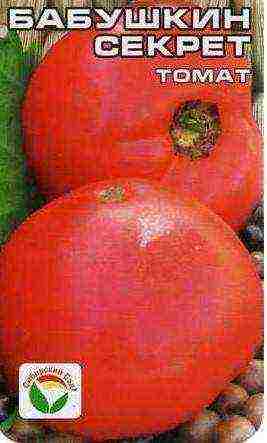
The variety Babushkin's secret is mid-season. Ripening period 94-118 days. The variety is grown for cultivation in all regions of Russia, mainly in greenhouse conditions.
With proper care, you can get 12-17 kilograms of fruit per square meter.
The variety is indeterminate. The height of the bush reaches 1.50 meters or more. The leaves are large, dark green.
3-5 fruits are formed on one hand.
Fruits are ribbed, flat-round in shape. The skin is pink in color. The fruits are large. Fruit weight 350-700 grams. The taste is excellent. The pulp is juicy, fleshy and sweet.
The fruits are intended for fresh consumption. Storage is short, transportation is poorly tolerated.
Reviews:
Anna:
I really liked the variety, I like large and fleshy tomatoes, they are well suited for salads. I believe that the variety is what you need for greenhouses. It is imperative to tie these tomatoes, I once forgot about the garter, so the bushes all broke from the weight of the fruits. If you follow all the rules of cultivation, then a rich harvest is guaranteed!
Stellate sturgeon

The Sevryuga variety is mid-season. From the emergence of seedlings to the ripening of the crop, 110-115 days pass.
It is adapted to the harsh northern and Siberian conditions. Grown in greenhouse conditions.
The plant is resistant to high humidity, drought, low temperatures and various diseases.
The bush is indeterminate. The average height reaches 140 centimeters. The plant branches easily. The stems are relatively thin, not strong. The plant needs a garter.
From one bush, the yield is at least 5 kilograms of tomatoes. 16 kilograms of fruit are removed from one square meter. Fruits with excess moisture are prone to cracking.
The shape is heart-shaped or flat-round. Fruits are smooth or ribbed with small dents on the surface of the fruit.
In an unripe form, the fruits are greenish, and in ripe form, it becomes pink-raspberry.
The pulp is moderately soft, very juicy. There are few seed chambers, no more than 4 pieces. The skin is of medium density. The size is large. Weight ranges from 270-350 grams, sometimes up to 1.5 kilograms. The taste is excellent. The aroma is pronounced.
According to the purpose, the fruits are universal. Suitable for salads, juice, puree. Storage is short. Transportation is difficult. The fruits must be consumed within 20 days of harvest.
Reviews:
Iriska11
I really liked Sevruga. Moreover, Sevryuga and a re-grade, which grew out of the same bag. On another forum, she was named Severyuga. Delicious, large, juicy, fruitful.
Auria
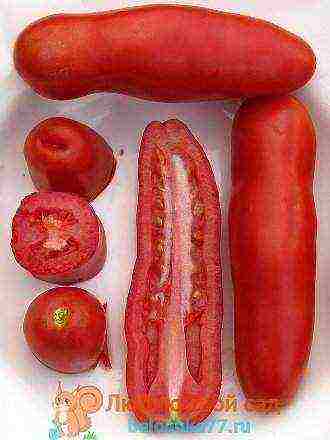
The Auria variety has a high yield and excellent fruit taste. The tomato is not afraid of temperature extremes, drought. Disease resistance is high.
For the middle zone and Siberia, the variety is recommended for growing in greenhouses. Open cultivation is suitable for the South.
The bush is indeterminate, not spreading. It is a liana, reaching 1.8 meters in height. In a greenhouse, the plant grows over 2 meters. There are few branches, they are thin. Average leafiness.
Bushes for a good harvest need to be formed by removing stepchildren. The fruits are formed on the brush.
The fruit is elongated, up to 15 centimeters in length. Tomato with lumpy walls. Fruit weight ranges from 80 to 200 grams. Seed chambers 2 pieces. The seeds are small, evenly distributed over the pulp. The pulp is fleshy, slightly juicy. The skin is thin, dense, red. The pulp is a little sweetish, unripe - not expressed. The fruits do not crack, they are well stored.
The fruits are suitable for preservation, making tomato paste and puree. Dense pulp does not crack during heat treatment.
Tomatoes have an excellent presentation, tolerate transportation well. They are not stored for long.
Reviews:
Alena, Latvia
Collected seeds, fruits were taken from one productive and healthy bush. Despite the peculiar seed chambers and the shape of the fruit, this variety is very fleshy, soft, juicy. The first time I cut the fruits lengthwise, before that they just ate a sausage. Delicious, but dolomite must be cooked. It is on friendly terms with the top, but the bush itself is very healthy and beautiful.
Harvest varieties of tomatoes for open ground
Mongolian dwarf
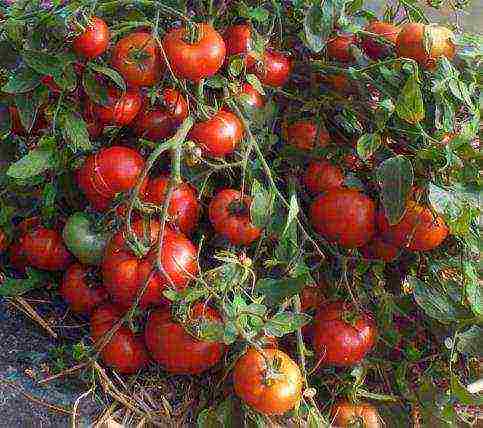
The variety is early, unpretentious. Grown in the open field. Fruiting is extended. The fruits are tied almost after planting the seedlings in the ground, this process in warm weather lasts until late autumn. The variety is resistant to drought, cold weather, winds. Does not undergo late blight.Widely distributed in Siberia and Transbaikalia.
A low bush reaches a height of 15-35 centimeters. In width it grows up to 1 meter wide. The stem is strongly branched, its central part is absent. 3-5 stems are formed from the root collar. The root system is powerful. Leaves are narrow, strongly pubescent. Fruits do not crack, are covered with leaves. The plant does not need pinching.
Fruits are bright red in color, juicy, dense. Rounded shape. Fruit weight reaches 200 grams. The pulp is slightly sour. The fruit tastes good both fresh and canned. They are perfectly stored, transported without problems.
Reviews:
KIL
I plant the Dwarf all the time, my favorite variety, or maybe he just loves me. The taste is average, depending on the weather, but very early and fertile and fruitful, almost a bucket from a bush 40 cm high. Begins to bear fruit in early July and until mid-August ... then I take off everything, because growing in exhaust gas, pouring ice water from a hose ...
Shar Pei
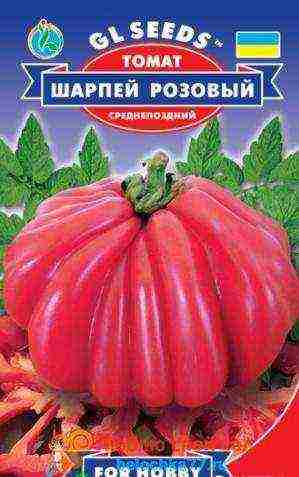
The Sharpei variety is mid-season, high-yielding, stress-resistant. Yields are always good regardless of the weather.
The crop ripens in 110-115 days. Fruiting lasts until frost.
The bush is strong, reaching a height of 1.8-2 meters. The plant is grown in 2-3 stems. Ripening on the brushes is amicable.
The skin of the fruit is pale pink. The shape is pear-shaped, with large ribs. Average weight, ranging from 100 to 200 grams.
Fruits are dense, fleshy, firm, slightly hollow. The taste is sweet.
The variety is suitable for lace cutting, making tomato paste and thick sauces.
Reviews:
ElenaN
Mid-season, closer to late, indeterminate tall variety, in the greenhouse was 1.9 meters high. Fruits - in the form of a pear, with pronounced ribs, pink, the taste turned out to be an ordinary tomato, slightly sour. Will be good in jars in color, shape and size, yield is good.
The best varieties of tomatoes for the Moscow region
The following varieties and hybrids are considered the best varieties for the Moscow region: Babushkino, Medovy, King of Kings, Babushkin's Secret, as well as Solnechny, Peremoga, Maryushka, Lyana, Blues, Grain, Olya, Mars and others.
There are even more varieties in the article “Tomato varieties with photos and descriptions”.
Varieties for the Urals and Siberia
For the Urals and Siberia, such varieties and hybrids are suitable as: Grandee, Primadonna, Eupator, Babushkin's Secret, Sevryuga, Auria, Mongolian Dwarf, as well as Alaska, Taimyr, White filling, Krasnaya Arrow, Alpatieva 905a, Rose of the Winds, Betta, Metelitsa, Far North, Snowdrop, Polar precocious, Moskvich, Polar, Siberian precocious, Bullfinch, Snowy tale and others.
Another selection of varieties in the article "The best varieties of tomatoes for greenhouses".
Choosing new seeds of tomatoes, peppers and cucumbers: video
All high-yielding tomato varieties require basic care. If you follow them, they give tasty and high-quality fruits.
There are a great many varieties of black currant. But from all this variety, you need to choose exactly those that are suitable for the site where they will grow. Each variety is good in its own way, but not everyone will grow well in certain climatic conditions. Some species mature early.
There are medium and late varieties that begin bearing a little later. Caring for different types of culture also differs. Everyone wants to have good harvests of berries at the same time, combined with large sizes of fruits and their excellent taste.
This article describes the best black currant varieties for central Russia, their features and photos, as well as advantages and disadvantages, which will help gardeners, especially beginners, to make the right choice, on which the quality and quantity of the future harvest will depend.
Varieties
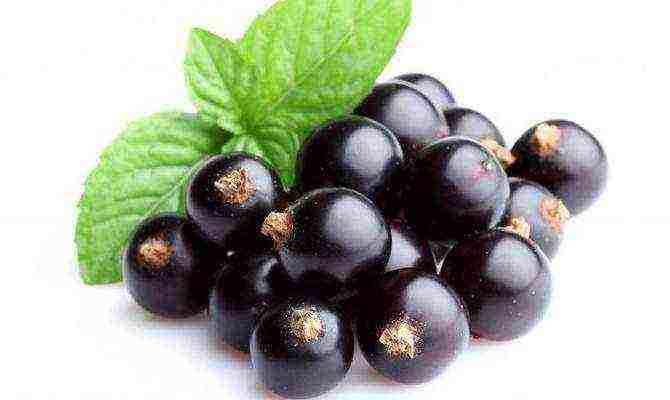
For cultivation in the middle lane, there are a huge number of varieties of black currant, which will not be enough to list and describe in one article.For different sites with their individual characteristics, it is rather difficult to choose a suitable variety from such a species abundance, however, this must be done.
The best varieties of black currant can be safely attributed to:
- Raisin;
- Summer resident;
- Selechinskaya 2;
- Exotic;
- Dubrovskaya;
- Black Pearl;
- Titania;
- Pygmy;
- Bagiru;
- Vologda;
- Mermaid;
- Dobrynya;
- Nuclear;
- Nina;
- Excellent student.
They are divided into:
- early varieties;
- medium;
- late.
And also on:
- large-fruited;
- sweet.
Early
Early blackcurrant species begin to bear fruit from the end of June. Of the early types of berries, the most popular are:
- Raisin;
- Summer resident;
- Selechinskaya 2;
- Exotic.
- Raisin
Variety Raisin
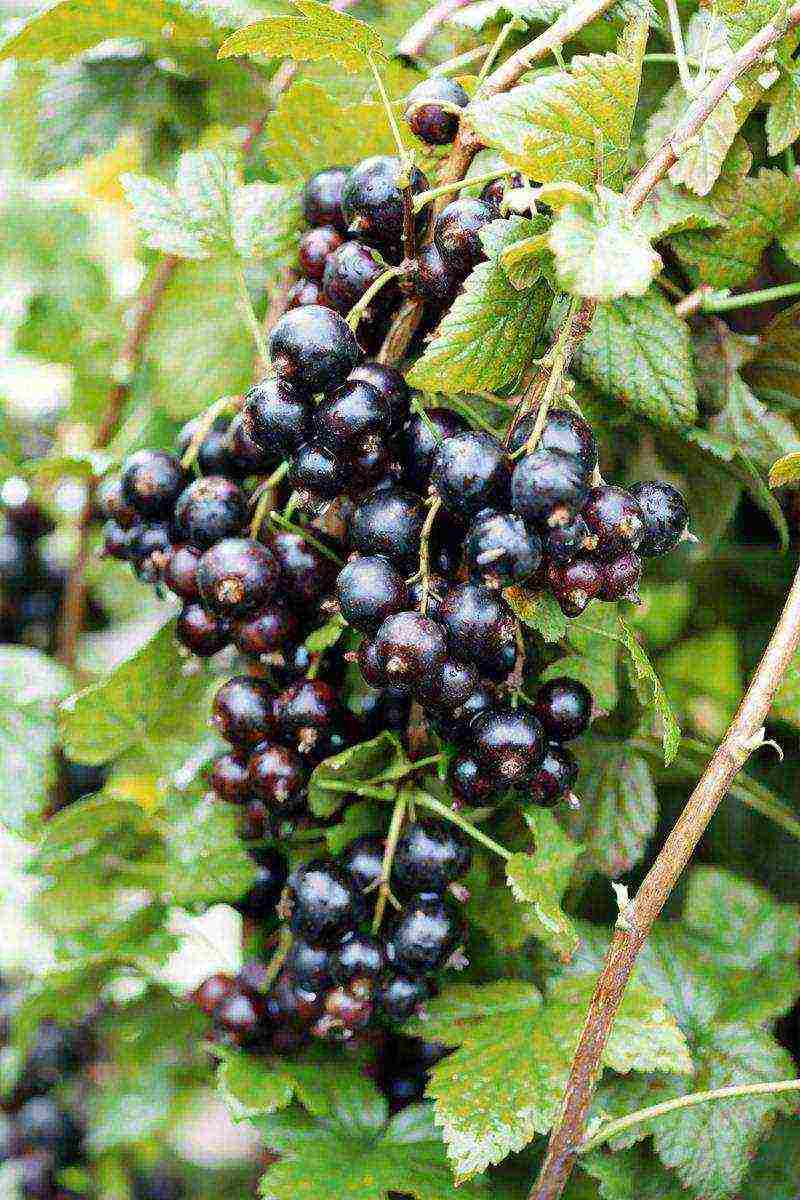
It was withdrawn at the end of the last century. In 2007 it was entered in the State Register for cultivation in the Central regions of Russia.
Raisin bushes are upright, medium-sized. The leaves are three-lobed, large, dark green in color, with a convex leathery matte plate. Flowers - pale yellow, large, collected in a brush.
Berries are round, large (up to 3.2 g), black, matte. The taste of the fruit is sweet, full-bodied.
100 g of berries contains:
- sugars - 9.1%;
- vitamin C - 192 mg;
- acids - 1.8%.
Productivity - up to 3.5 kg per bush.
The berries do not crumble, which is very pleasing to gardeners who come to their plots only on weekends. Fruits ripen early - at the end of June you can feast on aromatic sweet berries.
The variety is frost-hardy, tolerates drought well. Excellent resistance to diseases (kidney mites, powdery mildew, fungal diseases).
The advantages include:
- winter hardiness;
- resistance to weather disasters;
- large-fruited.
Flaws:
- poor rooting by lignified cuttings.
Summer resident

The early Dachnitsa variety is one of the most popular in Russia. It was withdrawn in 2004. Then it was entered into the State Register for cultivation in the Volgo-Vyatka and North-West regions of the country.
The bushes of the variety are compact, low, of medium density, spherical in shape. Young shoots are shiny, not pubescent, green in color. Older shoots are gray-brown with a brown top. Five-lobed, corrugated, medium-sized leaves, have a green, bronze tint, color. Flowers of medium size are pale, inconspicuous.
The fruits of the variety are large enough. The mass of one berry is 2 or more grams.
There are super-large specimens up to 5 g. The color of the berries is black. The thin skin is almost invisible when eaten. The pulp is juicy, rich, the taste is harmonious, sweet, with a pronounced aroma.
100 g of berries contain:
- sugar - 9.3%;
- vitamin C - 193.6 mg.
On a five-point scale, the taste of the Summer Resident is rated at 4.6 points.
The variety is early. Plants begin to bloom in May, and already at the end of June the first berries ripen.
The self-fertility of this type of currant is very high, however, if you plant other varieties of crops nearby, then the yield of the Summer resident will increase several times.
The yield is high. More than 1.5 kg of fruit can be harvested from one bush.
The advantages of the variety include:
- early onset of fruiting (in the third year, the first crop appears, the peak of which
- falls on the age of the bush 5-8 years);
- high productivity;
- excellent taste;
- self-fertility;
- high frost resistance;
- resistance to diseases and pests (powdery mildew and kidney mites).
The Summer Resident also has disadvantages:
- if the berries are not removed in time, they will become soft and crumble;
- with a large load of fruits, the branches bend down, and sometimes even break.
Selechenskaya 2

Selechenskaya 2 was withdrawn in 2000. Recommended for cultivation in the Central Region, North-West and West Siberian Districts.
Bushes - tall, erect. The leaves are three-lobed, dark green in color, leathery, wrinkled, boat-shaped. Light, red-violet flowers are collected in bunches of 800 pieces.
Large black berries weighing up to 4.5 g, densely located on the branches.The pulp is greenish, fragrant and tender, has a sweet taste with some sourness.
Composition of 100 g of pulp:
- sugar - 7.3%;
- acids - 2.2%;
- vitamin C - 160 mg.
Taste qualities on a five-point scale are estimated at 4.9 points. Ripening is early. At the end of June, you can taste the first berries.
The bushes begin to bear fruit already in the second year, and by 3-4 years up to 5 kg of berries are harvested from one plant.
Advantages:
- high productivity;
- excellent taste (the variety is considered almost the most delicious);
- anthracnose and powdery mildew resistance;
- large-fruited;
- good winter hardiness.
Flaws:
- relative resistance to kidney mites;
- instability to damage by aphids.
Exotic
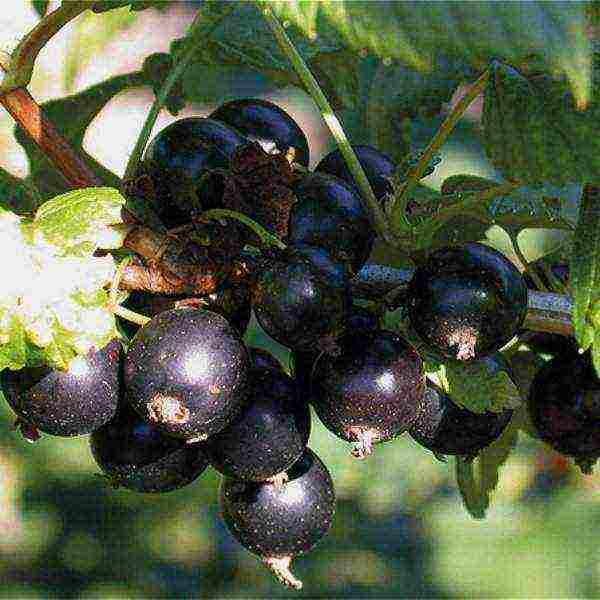
The variety was registered in the State Register in 2001 for cultivation in the Central region of Russia.
Upright and hardy plants - vigorous, sturdy, with strong branches of medium thickening. Leaves are five-lobed, large, dark green in color. White large flowers are collected in clusters. The berries are very easy to pick, as they are arranged in massive bunches similar to grapes.
The fruits of the variety are large. One berry reaches a mass of 5 or more grams. Their color is black, their shape is rounded. The pulp is fragrant, juicy, has a sweet and sour pronounced taste. The skin is thin, not felt when eating.
100 g of berry pulp contains:
- sugar - 8.9%;
- vitamin C - 198 mg.
The flowering of the bushes begins in May, and the first fruits ripen in June. The variety has high self-fertility, excellent winter hardiness (up to -25 degrees) and resistance to diseases, in particular, to columnar rust and powdery mildew. Productivity is quite high (more than 3 kg of berries per bush).
Advantages:
- high productivity;
- good frost resistance;
- large-fruited;
- excellent taste;
- powdery mildew resistance;
- good self-fertility.
Flaws:
- poor transportability;
- vulnerability to dry weather;
- during harvesting, mechanical damage is possible due to the presence of too thin
- peels on fruits:
- hypersensitivity to lesions with septoria, anthracnose, terry, kidney mites.
Medium varieties
Fruiting of medium varieties begins in mid-July. The average includes:
- Dubrovskaya;
- Black Pearl;
- Titania;
- Pygmy.
A characteristic feature of these varieties is the large berry size and long-term fruiting.
Dubrovskaya
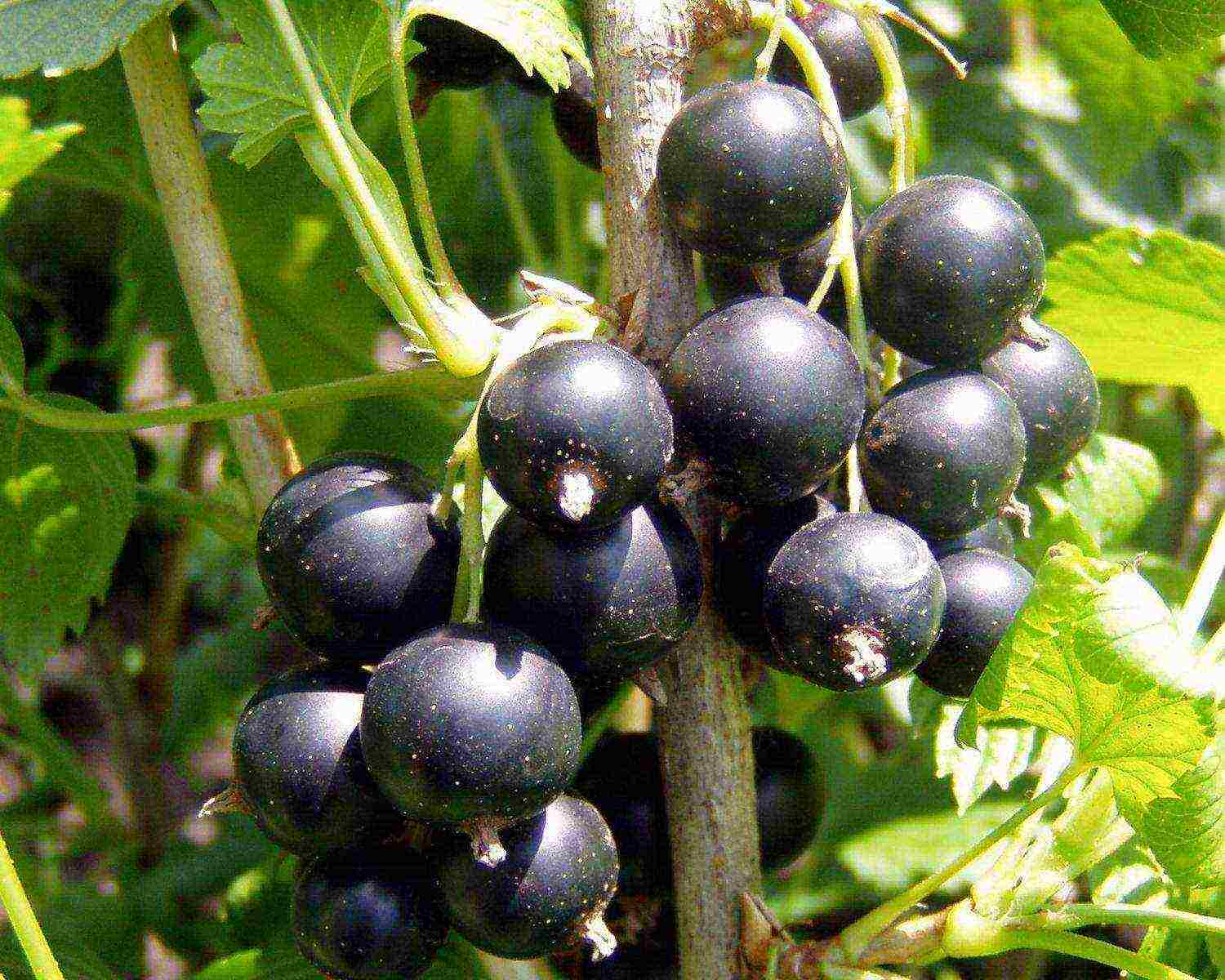
The variety was bred in 1988, and since then it has been successfully grown in the territories of the Volga-Vyatka and Central regions.
Bushes of the species are medium-sized and compact, beautifully shaped and of medium density. Leaves are juicy green, leathery and wrinkled, medium in size. The flowers are small in size, light green in color, and resemble cups in shape.
The berries are black and normal in size. The mass of one berry is 2.3 g. The taste of the fruit is intense, sweet and sour. Ripen in mid-July.
100 g of fruit contains:
- sugar - 7.2%;
- acids - 2.0%;
- vitamin C - 200.4 mg.
On a five-point system, taste can be estimated at 4.5 points.
Dubrovskaya is a very productive variety. Up to 3.8 kg of juicy berries are harvested from one bush.
This type of black currant is characterized by high frost resistance, good self-fertility, sufficient resistance to kidney mites.
The advantages include:
- high productivity;
- large-fruited;
- self-pollination;
- good taste;
- resistance to kidney mite damage.
Flaws:
- increased incidence of anthracnose, powdery mildew;
- tendency to overgrowth and thickening.
Black Pearl
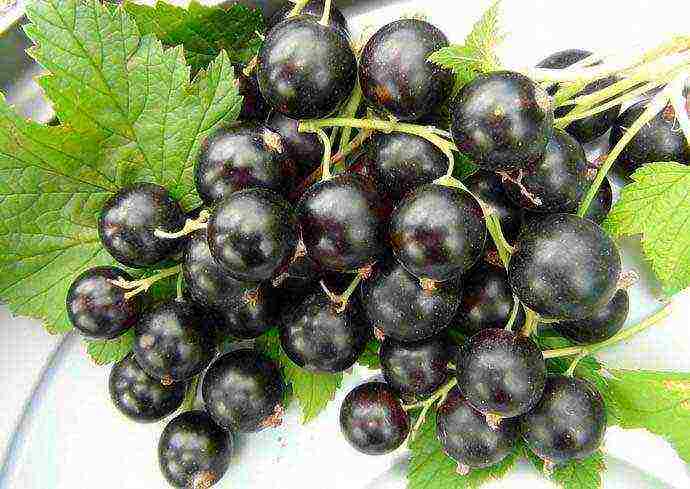
Bred Black Pearl in 1992. The variety is successfully cultivated in the Middle Volzhsky, Central Black Earth regions, in the North Caucasian District.
The bush of the variety is medium-sized with a small number of branches of weak thickening. Leaves are five-lobed, light green, with curved edges. Flowers, goblet-shaped, medium-sized, collected in a brush.
Fruits are round, black, glossy, of color, rather large (weighing 6 g).The pulp is juicy, sweet and sour, with large seeds. The fruits reach maturity by mid-July.
Composition of 100 g of berries:
- sugars - 8.0%;
- acids - 1.7%;
- vitamin C - 133 mg.
On a five-point scale, taste is rated at 4.2 points.
The variety has good transportability and keeping quality, as well as high yield, up to 3 kg per bush. Black pearls are hardy and moderately resistant to powdery mildew.
Advantages:
- good productivity;
- high taste and presentation;
- decent frost resistance;
- the variety can be transported over long distances without losing its taste and presentation.
Flaws:
- sour taste that not everyone likes;
- medium resistance to powdery mildew.
Titania

The variety was bred by Swedish breeders in 1970. It appeared in Russia in 1995.
Titania is characterized by the fact that the branches of the plants are directed upwards. The bush itself resembles a ball. Leaves are medium in size, wrinkled, bright green in color.
Fruits are black, large (up to 4 g in weight). The pulp is dark green, juicy. Taste - sweet and sour, dessert, with wine notes.
Composition 100 g:
- sugar - 6.6%;
- acids - 3.2%;
- vitamin C - 170 mg.
On a five-point scale, taste is rated at 4.7 points.
Titania has excellent transportability and keeping quality, which allows it to be cultivated on an industrial scale. The yield of the variety is up to 3.5 kg per plant.
Advantages:
- high frost resistance;
- large-fruited;
- consistently high yields;
- lack of shedding;
- good transportability;
- high resistance to morbidity.
Flaws:
- tendency to overgrow;
- chopping berries in the absence of care;
- high requirements for soil moisture and nutrient composition.
Pygmy

Pygmy was created in 1999 and is cultivated in the Volgo-Vyatka, West Siberian and Ural regions.
The bush is compact, medium spreading, medium thickening. The leaves are bright green, wrinkled, large in size. Flowers - small, pale, similar to saucers, collected in a brush.
The berries are black, shiny, very large (up to 7.5 g), have a sweet taste and rich aroma. The variety gives amazing yields - up to 5.7 kg per bush.
Composition 100 g:
- sugar - 8.7%;
- vitamin C - 170 mg.
Pygmy has an amazing frost resistance (up to -32 degrees), high self-fertility, resistance to anthracnose and powdery mildew. It is characterized by long-term fruiting and unpretentious care.
Advantages:
- drought tolerance;
- self-fertility;
- frost resistance;
- high productivity;
- large-fruited;
- sweet taste;
- resistance to anthracnose and powdery mildew.
Flaws:
- vulnerability to kidney mites and septoria.
Late varieties
Late varieties include those that begin to bear fruit from the end of July and continue to ripen until the end of August.
Of these, it can be noted:
- Bagiru;
- Vologda;
- Mermaid.
Bagheera

The variety was included in the State Register in 1990 for cultivation in the North-West, Volgo-Vyatka, Ural, Middle Volga, West Siberian and East Siberian regions.
The bushes are medium-sized, characterized by rather rapid growth. Plants shed their foliage late.
Leaves are five-toed, light green, matte, with wavy edges. Flowers - medium-sized, goblet-shaped.
Berries are black in color, medium in size (weighing up to 2 g) have a juicy tender pulp, sweet taste, with a pleasant sourness.
100 g of pulp contains:
- sugar - 12%;
- acids - 3.5%;
- vitamin C - 190 mg.
Productivity - up to 4.5 kg per bush. It tolerates both cold and heat well. It has a high, up to -32 degrees, frost resistance, and an average resistance to pests and diseases. It is perfectly transported over long distances without losing its marketability and taste.
Advantages:
- early maturity;
- good self-fertility;
- high productivity;
- decent frost resistance and drought resistance;
- excellent transportability and keeping quality.
Flaws:
- insufficient resistance to kidney mites and powdery mildew;
- vulnerability to direct sunlight.
Vologda

Vologda entered the State Register in 1995 for cultivation in the North-West, Central, Volgo-Vyatka, Middle Volga and Far Eastern districts.
The bush is medium, spreading, rather dense. Dark green, large, asymmetrical leaves are bent down. Medium-sized flowers are collected in clusters.
Fruits are black, round, weighing up to 3 g. The pulp is juicy and tender, covered with an elastic skin, has a sweet and sour taste and a pronounced aroma.
100 g of fruit contains:
- sugar - 7.5%;
- vitamin C - 175 mg.
Taste is rated on a five-point scale at 4.5 points.
The variety is hardy, easily adapts to any weather conditions. Fruit shedding is absent. The yield is high - up to 4 kg per plant. Vologda is highly transportable.
Advantages:
- frost resistance up to -28 degrees;
- high productivity;
- excellent taste and marketability;
- good keeping quality and transportability;
- large-fruited;
- disease resistance.
Flaws:
- bushes require support;
- fruits crack when overripe;
- uncooked ripening of berries.
Mermaid
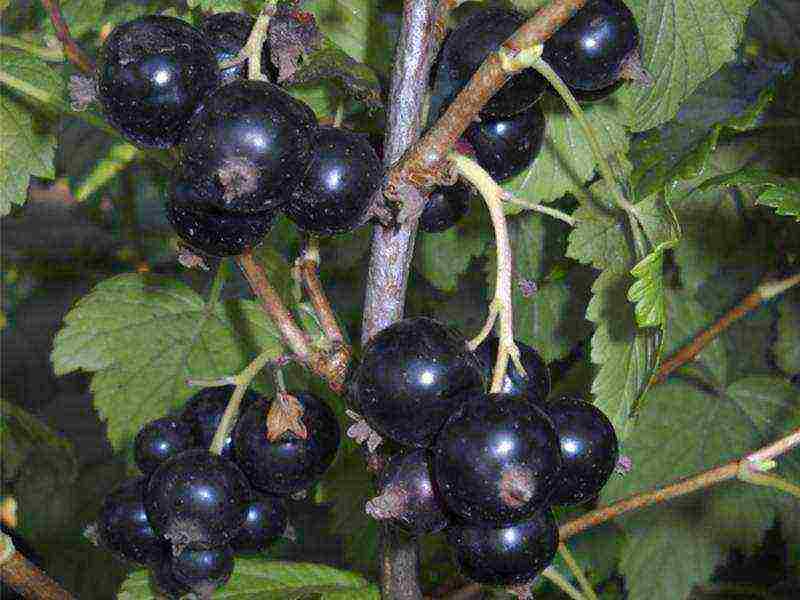
The variety was included in the Gosrestr in 2004. It is successfully cultivated in the middle lane and the Central region of Russia.
Plants - medium-sized, spreading, medium thickening. Leathery, shiny leaves of large size, have a dark green color. Small light pink goblet flowers are collected in a brush.
The berries are simply huge, up to 7.5 g each. Juicy tender pulp has an excellent sweet dessert taste. Productivity - up to 3 kg per bush.
100 g of pulp contains:
- sugar - about 10%;
- acids - 1.6%;
- vitamin C - 186 mg.
Plants are susceptible to septoria disease and kidney mite attacks. The variety is self-fertile, frost-hardy, resistant to powdery mildew and anthracnose.
Advantages:
- high productivity;
- large-fruited;
- frost resistance;
- drought resistance;
- excellent taste.
Flaws:
- susceptibility to septoria disease and kidney mites.
Large-fruited varieties
In addition to the above, large-fruited include:
- Dobrynya;
- Nuclear.
Dobrynya
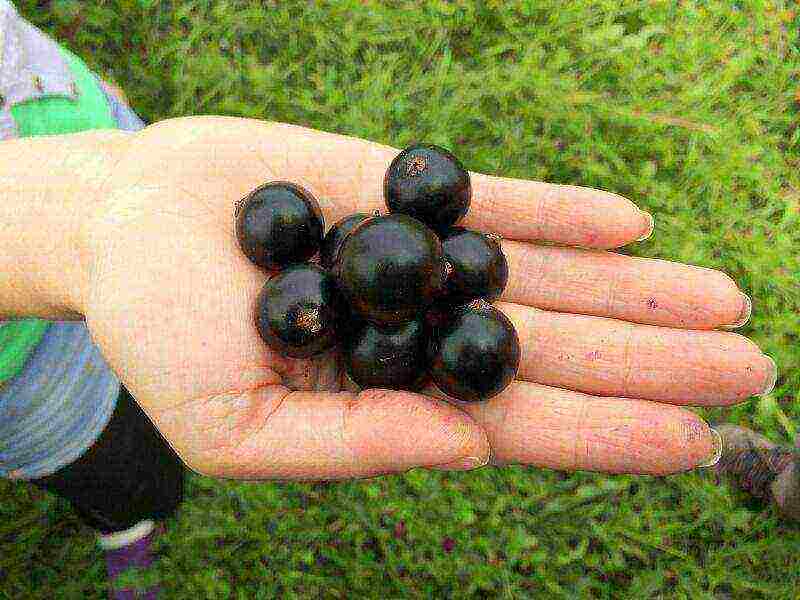
The mid-season hybrid Dobrynya was entered in the State Register in 2004 for cultivation in the Central and West Siberian districts.
Bushes of plants are compact, medium-sized. The bright green three-lobed leathery leaves are large in size. The flowers are also large, white-yellow, collected in inflorescences. The variety begins to bloom at the end of April. Flowering lasts 10 days.
The berries are black, with a blue tint, weighing up to 7 g, and are very large in size. The pulp is juicy. The skin is firm and elastic. The taste is sweet and sour, harmonious.
100 g of berries contain:
- sugars - 6.9%;
- acids - 2.5%;
- vitamin C - 200 mg.
On a five-point scale, taste is rated at 4.8 points.
The variety has good, up to -25 degrees, frost resistance and an average yield, up to 1.6 kg per plant.
Advantages:
- large-fruited;
- stable yield;
- frost resistance and drought resistance;
- good transportability and keeping quality of fruits;
- excellent taste;
- high resistance to powdery mildew.
Flaws:
- uncooked ripening of berries;
- susceptibility to fungal diseases and anthracnose, as well as kidney mites.
Vigorous
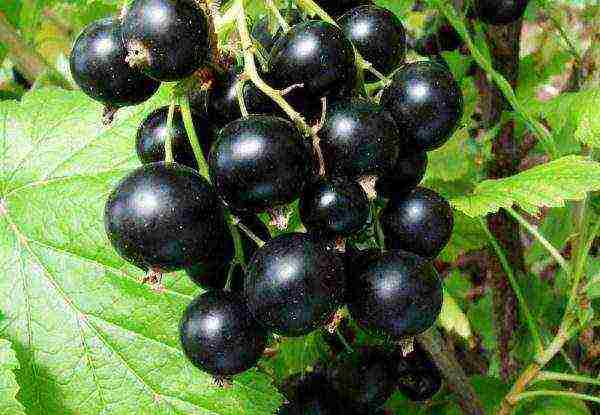
One name speaks for itself!
The variety was registered in the State Register in 2000 for cultivation in the West Siberian and Volgo-Vyatka regions.
The bush of the plant is medium-sized, with a small amount of foliage. Long branches are simply covered with large berries. Leaves are large, dark green, matte. Flowers are small, white and pink.
Berries are black, plum-like, very large, weighing up to 8 g, have a pleasant, refreshing, slightly sour taste.
Composition of 100 g of fruits:
- sugar - 9%;
acid - 3.7%; - vitamin C - 96 mg.
The variety is late. Flowering begins in late May, and the berries begin to ripen in mid-July. The kernel is characterized as a type of black currant that is resistant to weather disasters. He doesn't care about heat or drought. The yield is also amazing - up to 6 kg are harvested from one bush.
Advantages:
- large fruits;
- rich harvests;
- good frost resistance;
- high resistance to kidney mites and powdery mildew;
- resistance to weather extremes.
Flaws:
- whimsical care;
- poor transportability;
- poor resistance to anthracnose.
Sweet varieties
Sweets include:
- Nina;
- Excellent student.
Those types of black currants are considered sweet if they contain 11 percent or more sugars and a minimum of acids.
Variety Nina

Nina is a mid-early high-yielding variety cultivated in the Central and Volga-Vyatka regions.
Bushes of plants are short, compact, rather dense. The leaves are large, leathery, dark green in color. Berries are black, medium in size, weighing up to 1.5 g.
Composition 100 g:
- sugar - 11%;
- vitamin C - up to 270 mg.
The variety is frost-resistant, high-yielding (up to 3.5 kg per bush).
Advantages:
- high sugar and vitamin C content;
- high self-fertility and productivity;
- excellent powdery mildew resistance.
Flaws:
- berries are practically not stored and transported.
An excellent pupil
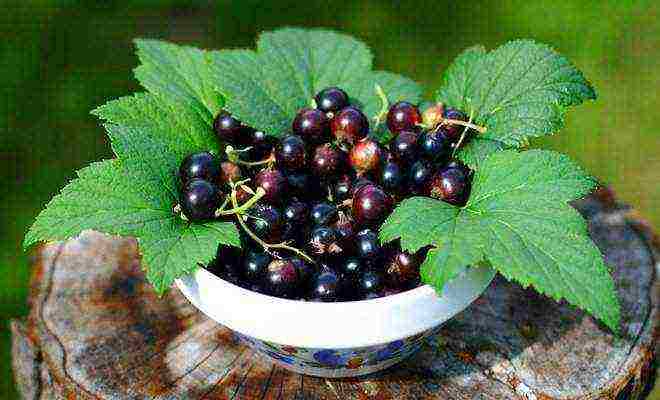
The variety has the highest sugar content. Cultivated in the Central regions, Volgo-Vyatka and North-West regions of the country.
Plants are vigorous, vigorous, with spreading dense branches. The leaves are three-lobed, light green in color, of medium size. Berries are black, large, weighing up to 2 g. Taste is rich-sweet, with a slight sourness. Ripening - amicable, falls in mid-July.
100 g of pulp contains:
sugar - about 12%;
vitamin C - 230 mg.
Yields are high, up to 4.5 kg per plant. Differs in high frost resistance, and is resistant to spring frosts.
Advantages:
- high productivity;
- high sugar and vitamin C content;
- resistance to weather extremes.
Flaws:
- poor resistance to morbidity.
All the varieties listed above are worthy representatives of the culture called black currant. Any of them will decorate with dignity a garden plot located in central Russia and not only there. Delicious and aromatic berries will perfectly complement the daily diet of any table. The choice is yours!

